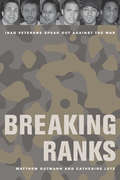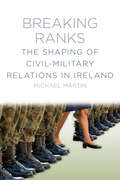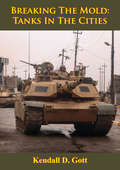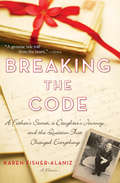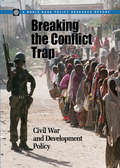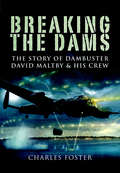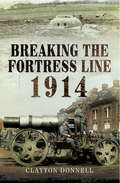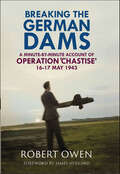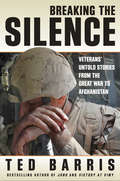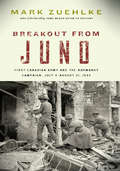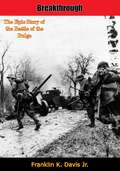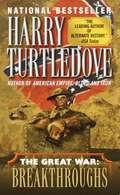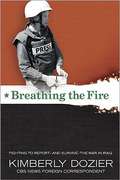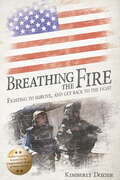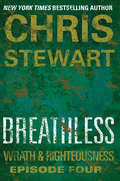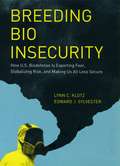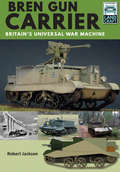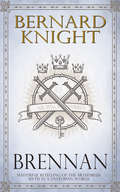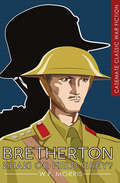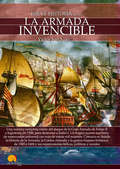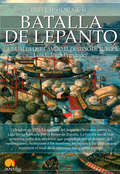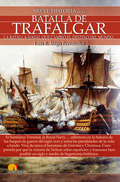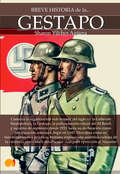- Table View
- List View
Breaking Ranks: Iraq Veterans Speak Out Against the War
by Matthew C. GutmannBreaking Ranks brings a new and deeply personal perspective to the war in Iraq by looking into the lives of six veterans who turned against the war they helped to fight. Based on extensive interviews with each of the six, the book relates why they enlisted, their experiences in training and in early missions, their tours of combat, and what has happened to them since returning home. The compelling stories of this diverse cross section of the military recount how each journey to Iraq began with the sincere desire to do good. Matthew Gutmann and Catherine Anne Lutz show how each individual's experiences led to new moral and political understandings and ultimately to opposing the war.
Breaking Ranks: The Shaping of Civil-Military Relations in Ireland
by Michael MartinIn the late 1980s, the 'army crisis' was dominating headlines in Ireland. Complaints of poor pay, low morale and unsatisfactory conditions for those serving in the Defence Forces were growing louder against the background of a government accused of being indifferent and an army hierarchy accused of being incapable. From amidst the turmoil, a group of women stepped up to pursue the rights of their men. Political crisis and a general election followed, but a commission established to examine the Defence Forces ignored the call for soldiers to acquire their own representative body. This book reveals for the first time, the deep-seated philosophies, tensions and reservations between Ireland's military and its government from the foundation of the State to the present day. It explores in detail the events that led to the successful pursuit of the democratic right of association for members of the armed forces in Ireland. It articulates the concept of the citizen in uniform and the special relationship between members of the armed forces and society. This is the story of the breaking of ranks.
Breaking The Mold: Tanks In The Cities [Illustrated Edition]
by Kendall D. GottIllustrated with 30 maps.Few lessons are as prevalent in military history as is the adage that tanks don't perform well in cities. The notion of deliberately committing tanks to urban combat is anathema to most. In Breaking the Mold: Tanks in the Cities, Mr. Ken Gott disproves that notion with a timely series of five case studies from World War II to the present war in Iraq.This is not a parochial or triumphant study. These cases demonstrate that tanks must do more than merely "arrive" on the battlefield to be successful in urban combat. From Aachen in 1944 to Fallujah in 2004, the absolute need for specialized training and the use of combined arms at the lowest tactical levels are two of the most salient lessons that emerge from this study. When properly employed, well-trained and well-supported units led by tanks are decisive in urban combat. The reverse is also true. Chechen rebels taught the Russian army and the world a brutal lesson in Grozny about what happens when armored units are poorly led, poorly trained, and cavalierly employed in a city.The case studies in this monograph are high-intensity battles in conflicts ranging from limited interventions to major combat operations. It would be wrong to use them to argue for the use of tanks in every urban situation. As the intensity of the operation decreases, the second and third order effects of using tanks in cities can begin to outweigh their utility. The damage to infrastructure caused by their sheer weight and size is just one example of what can make tanks unsuitable for every mission. Even during peace operations, however, the ability to employ tanks and other heavy armored vehicles quickly can be crucial. A study on the utility of tanks in peace operations is warranted, and planned.- Timothy R. Reese Colonel, Armor
Breaking the Code
by Karen Fisher-AlanizOn his 81st birthday, without explanation, Karen Alaniz's father placed two weathered notebooks on her lap. Inside were more than 400 pages of letters he'd written to his parents during WWII. She began reading them, and the more she read, the more she discovered about the man she never knew and the secret role he played in WWII. They began to meet for lunch every week, for her to ask him questions, and him to provide the answers. And with painful memories now at the forefront of his thoughts, her father began to suffer, making their meetings as much about healing as discovery. Thus began an unintended journey—one taken by a father and daughter who thought they knew each other—as they became newly bound in ways that transcended age and time.
Breaking the Conflict Trap: Civil War and Development Policy
by World BankCivil war conflict is a core development issue. The existence of civil war can dramatically slow a country's development process, especially in low-income countries which are more vulnerable to civil war conflict. Conversely, development can impede civil war. When development succeeds, countries become safer--when development fails, they experience a greater risk of being caught in a conflict trap. Ultimately, civil war is a failure of development. 'Breaking the Conflict Trap' identifies the dire consequences that civil war has on the development process and offers three main findings. First, civil war has adverse ripple effects that are often not taken into account by those who determine whether wars start or end. Second, some countries are more likely than others to experience civil war conflict and thus, the risks of civil war differ considerably according to a country's characteristics including its economic stability. Finally, Breaking the Conflict Trap explores viable international measures that can be taken to reduce the global incidence of civil war and proposes a practical agenda for action. This book should serve as a wake up call to anyone in the international community who still thinks that development and conflict are distinct issues.
Breaking the Dams: The Story of Dambuster David Maltby and his Crew
by Charles FosterThis is the story of the authors uncle, David Maltby and the crew with whom he flew on the famous Dam Raid in 1943. Just five months later, on their return from an aborted mission to bomb the Dortmund Ems Canal, they all died when their aircraft went down in the North Sea. Only Davids body was recovered, washed ashore a day later, and identified by his 18 year old sister the authors mother. David was the pilot of the fifth Lancaster, J-Johnny to drop a bomb on the Mhne Dam and cause the final breach in the dam. He was then just 23 years of age, but already had 30 operations and a D.F.C. to his name.This book tells the story of the crew, what made them join the RAF when they new the risk was so high, how fate threw them together, what it was like for one crew to take part in the raid and what happened to them in the five months between Operation Chastise and their deaths. It goes beyond the raid to look at what happened afterwards and how the families left behind were affected. Their sons, brothers and fathers might have become famous but they had to cope with life and loss in the same way as did thousands of other British families.
Breaking the Fortress Line, 1914
by Clayton DonnellBreaking the Fortress Line 1914 offers a fascinating new perspective on the German offensive against France and Belgium in 1914. In graphic detail it describes the intense fighting that took place around the forts and fortified cities that stood in the path of the German invasion. The ordeal began with the German assault on the mighty fortress of Lige. They took twelve days to batter their way through the 'Gateway to Belgium', losing thousands of men in repeated frontal assaults, and they had to bring up the heaviest siege artillery ever used to destroy the defences.This is the epic struggle that Clayton Donnell depicts in this compelling account of a neglected aspect of the battles that followed the outbreak of the Great War. Not only does he reconstruct the German attack on the strongpoints they encountered along the entire invasion line, but he traces the history and design of these fixed defences and analyses the massive military building programmes undertaken by the French, the Germans and the Belgians between 1871 and 1914. Thousands of huge forts, infantry strongpoints, bunkers, casemates and shelters were dug out along the French and German borders. The German Moselstellung and Steinbruch-stellung were born. These massive concrete fortress systems with steel gun turrets and diesel motors to generate electricity were a completely new concept of fortress design.As war approached, France and Germany devised plans to overcome each other's powerful armies and these border defences. The French plan avoided contact with the German fortress system. But the Kaiser's army faced twelve forts at Lige, nine more at Namur, and then the strongpoints of the first and second Sr de Rivires lines. Clayton Donnell provides a gripping narrative of the violent confrontation that followed.
Breaking the German Dams: A Minute-By-Minute Account of Operation 'Chastise', May 1943
by Robert OwenAn in-depth account of one of the greatest aviation bombing operations in World War II history: the RAF’s Dambusters Raid against Nazi Germany.“This was Der Tag for 617 Squadron [. . .] from eight o’clock onwards the scenes outside the crew rooms were something to be remembered.” On the evening of Sunday 16 May, 1943, the sound of Lancaster bombers fills the night air around Lincolnshire as two waves of Allied aircraft start their engines and take off from RAF Scampton in the direction of the Ruhr Valley. The mission? Attack the German dams on the Eder, Möhne and Sorpe rivers using special “bouncing bombs”. This was Operation Chastise. In this remarkable work, No. 617 Squadron expert Dr Robert Owen takes a microscope to the raid, guiding readers through the events of 16 and 17 May 1943 in astounding chronological detail. Each action leading up to, throughout, and following the raid is signposted with a precise time stamp, affording readers an informative, gripping and easy-to-follow reading experience. Owen’s compilation of a wide range of first-hand accounts from those involved in the Dambusters Raid complements this minute-by-minute retelling perfectly, and adds to the readers’ understanding and appreciation of this astonishing military operation. With a foreword by World War II aviation expert and author James Holland, Breaking the German Dams is a hugely impressive feat of nonfiction writing about one of the most awe-inspiring operations in British military history. Readers will be left incredibly well-versed in—and moved by—the extraordinary story of Operation Chastise.
Breaking the Ring
by John BarronThe bizarre case of the espionage operation of the John Walker family and the U.S. government's hunt for the spy and his accomplices.
Breaking the Silence: Veterans' Untold Stories from the Great War to Afghanistan
by Ted Barris"Never talked about it." That’s what most people say when they’re asked if the veteran in the family ever shared wartime experiences. Describing combat, imprisonment or lost comrades from the World Wars, the Korea War, or even Afghanistan is reserved for Remembrance Day or the Legion lounge. Nobody was ever supposed to see them get emotional, show their vulnerability. Nobody was ever to know the hell of their war. About 25 years ago, Ted Barris began breaking through the silence. Because of his unique interviewing skills, he found that veterans would talk to him, set the record straight and put a face on the service and sacrifice of men and women in uniform. As a result of his work on 15 previous books, Barris has earned a reputation of trust among Canada’s veterans. Indeed, over the years, nearly 3,000 of them have shared their memories, all offering original material for his books. Among other revelations in Breaking the Silence, veterans of the Great War reflect on an extraordinary first Armistice in 1918; decorated Second World War fighter pilots talk about their thirst for blood in the sky; Canadian POWs explain how they survived Chinese attempts to brainwash them during the Korean War; and soldiers with the Afghanistan mission talk about the horrors of the "friendly fire" incident near Kandahar. Breaking the Silence is a ground-breaking book that goes to the heart of veterans’ war-time experiences.
Breakout from Juno
by Mark ZuehlkeThe ninth book in the Canadian Battle Series, Breakout from Juno, is the first dramatic chronicling of Canada's pivotal role throughout the entire Normandy Campaign following the D-Day landings.On July 4, 1944, the 3rd Canadian Infantry Division won the village of Carpiquet but not the adjacent airfield. Instead of a speedy victory, the men faced a bloody fight. The Canadians advanced relentlessly at a great cost in bloodshed. Within 2 weeks the 2nd Infantry and 4th Armoured divisions joined coming together as the First Canadian Army.The soldiers fought within a narrow landscape extending a mere 21 miles from Caen to Falaise. They won a two-day battle for Verrières Ridge starting on July 21, after 1,500 casualties. More bloody battles followed, until finally, on August 21, the narrowing gap that had been developing at Falaise closed when American and Canadian troops shook hands. The German army in Normandy had been destroyed, only 18,000 of about 400,000 men escaping. The Allies suffered 206,000 casualties, of which 18,444 were Canadians.Breakout from Juno is a story of uncommon heroism, endurance and sacrifice by Canada's World War II volunteer army and pays tribute to Canada's veterans.
Breakthrough: The Greatest Pitched Battle in America’s History
by Franklin M. Davis Jr“This battle,” Hitler said, “is to decide whether we shall live or die.”Skilfully, secretly, he assembled three German armies—24 divisions, 250,000 men, 970 tanks and 1900 pieces of artillery.Taking advantage of the harsh winter, he picked a place where the Allied forces were water-thin—four American divisions and one armored cavalry regiment—and unleashed a devastating attack to annihilate the outnumbered defenders.Thus started the greatest pitched battle ever fought by the United States in its history—the engagement that destroyed forever the myth of the vaunted superiority of the German soldier.
Breakthroughs (The Great War #3)
by Harry TurtledoveIs it the war to end all wars--or war without end? What began as a conflict in Europe, when Germany unleashed a lightning assault on its enemies, soon spreads to North America, as a long-simmering hatred between two independent nations explodes in bloody combat. Twice in fifty years the Confederate States of America had humiliated their northern neighbor. Now revenge may at last be at hand. Into this vast, seething cauldron plunges a new generation of weaponry changing the shape of war and the balance of power. While the Confederate States are distracted by an insurgency of African Americans who dream of establishing their own socialist republic, the United States are free to bring their military and industrial might directly to bear--and to unleash the most horrific armored assault the world has ever seen. Victory is at hand. But at a price that may be worse than war itself . . .
Breathing the Fire: Fighting to Report--and Survive--the War in Iraq
by Kimberly DozierCBS News correspondent Kimberly Dozier who battled back from critical injuries sustained in a Baghdad bombing offers a personal memoir of tenacity as well as dedication and drama. Readers learn what wounded military personnel--along with their families and friends--endure on the long road to recovery. Dozier also recounts her rise to network broadcasting, shares insights into the culture of war-zone reporting, and describes the unique demands and perils of women covering dangerous events.
Breathing the Fire: Fighting to Survive, and Get Back to the Fight
by Kimberly Dozier&“A harrowing tale of courage, survival, determination, fellowship and the high price of covering a war . . . a master storyteller and one tough journalist.&” —Tom BrokawCBS Foreign Correspondent Kimberly Dozier shares her compelling story from being injured in Iraq to her recovery . . . shedding light on the ordeal faced by countless combat veterans and civilians. In a flash, Kimberly Dozier&’s life changed. As an award-winning CBS News reporter, Dozier had devoted her career to being in the right place at the right time to capture the story. Suddenly, in the wrong place at the worst time, she became the story, as a deadly explosion tore through her team and the troops they were following, and a word spread worldwide. That Memorial Day in 2006, a routine mission ended with Dozier in a pool of blood on a Baghdad street, a victim of a car bomb that killed her team, cameraman Paul Douglas and soundman James Brolan, as well as U.S. Army Captain James Alex Funkhouser and his translator. Critically injured, Dozier woke to find herself fighting first for survival, then for recovery, and finally to return to the field. Breathing the Fire tracks one woman&’s relentless determination to get the story, to get it right, and to get well again after everything went wrong. The paperback was produced at the request of hospital caregivers, who find the book helps trauma patients and the families supporting them. The author&’s profits go to wounded warrior charities.&“A rare, personal view—with all the attention to detail a great reporter brings to bear—into an experience shared by thousands of wounded Iraq veterans.&” —Dan Rather
Breathless: Episode Four
by Chris Stewart"It really grips you....I lost a lot of sleep reading it." -Tim LaHaye, co-author of the LEFT BEHIND series THE WORLD CHANGES IN A FLASH "I want you to tell the president something for me. He has seven minutes. That is all. Seven minutes from now. I hope they are able to evacuate him before it happens, for I want him to see the death and destruction that he has caused. That is the only reason I am calling. I genuinely want him to live. I want him to see the downfall of his nation, the great whore of the earth. I want him to see his great city after it has been turned to black ash." The epic battle continues with an episode that will leave you breathless. A coordinated attack on Israel's government creates chaos in Jerusalem, but that is only the beginning. As the Israeli's respond it becomes evident that they've been set-up in the most ruthless way imaginable. With the world turned against them, the Israelis turn to the U.S. for help--but Saudi King Abdullah is already two steps ahead. After unleashing the final piece of his plan, it is no longer a question of whether America wants to save Israel, but whether they can save themselves. Against the backdrop of torn-from-the-headlines Middle Eastern drama, the Wrath & Righteousness series is a fast-paced thriller that explores man's role in the eternal battle between good and evil. Chris Stewart is the New York Times bestselling author of several books, including The Miracle of Freedom. He is a world-record-setting Air Force pilot (fastest nonstop flight around the world) and president and CEO of The Shipley Group, a nationally recognized consulting and training company. Wrath & Righteousness is a ten episode e-book series by New York Times bestselling author Chris Stewart. Each episode is approximately 50,000-60,000 words (roughly two-thirds the length of a normal full-length novel). This series was adapted from the previously published The Great and Terrible series that was released from 2003-2008.
Breeding Bio Insecurity: How U. S. Biodefense Is Exporting Fear, Globalizing Risk, and Making Us All Less Secure
by Lynn C. Klotz Edward J. SylvesterForceful and provocative, Breeding Bio Insecurity contends that U.S. bio defense policies generate more risk than the threat they are supposed to be addressing. By carefully spelling out their rationales, the book's authors place the burden of justification on the defenders of massive bio defense budgets. Replete with deft arguments and imaginative scenarios, this book should be read by scientists, policy makers and, indeed, all concerned citizens.
Bren Gun Carrier: Britain's Universal War Machine (LandCraft #3)
by Robert JacksonA guide that blends the history behind this British tank with resources for military vehicle modeling enthusiasts. One of the most versatile fighting vehicles in the British army and many other forces for a quarter of a century, the Universal Carrier—more popularly known by its original title of Bren Gun Carrier—was developed as a fast and agile infantry-support vehicle. In this volume of Pen & Sword&’s LandCraft series, Robert Jackson traces its design and manufacturing history and describes its operational role throughout its long career. The Bren Carrier served in every theater of the Second World War, from northwest Europe, North Africa and the Soviet Union to the Far East. Then, with the war over, it was operated by many belligerents in a string of other conflicts around the world, including Israel&’s struggle for independence and the war in Korea. A selection of archive photographs showing the Bren Carrier in action gives a graphic impression of how adaptable it was and records the variety of equipment it could carry. The book is an excellent source for the modeler, providing details of available kits together with specially commissioned color profiles which illustrate how the Bren Carriers used by different units and armies appeared.
Bren Gun Carrier: Britain's Universal War Machine (LandCraft)
by Robert JacksonA guide that blends the history behind this British tank with resources for military vehicle modeling enthusiasts. One of the most versatile fighting vehicles in the British army and many other forces for a quarter of a century, the Universal Carrier—more popularly known by its original title of Bren Gun Carrier—was developed as a fast and agile infantry-support vehicle. In this volume of Pen & Sword&’s LandCraft series, Robert Jackson traces its design and manufacturing history and describes its operational role throughout its long career. The Bren Carrier served in every theater of the Second World War, from northwest Europe, North Africa and the Soviet Union to the Far East. Then, with the war over, it was operated by many belligerents in a string of other conflicts around the world, including Israel&’s struggle for independence and the war in Korea. A selection of archive photographs showing the Bren Carrier in action gives a graphic impression of how adaptable it was and records the variety of equipment it could carry. The book is an excellent source for the modeler, providing details of available kits together with specially commissioned color profiles which illustrate how the Bren Carriers used by different units and armies appeared.
Brennan
by Bernard KnightSet in an alternate version of the early twenty-first century, Brennan is Bernard Knight’s masterful retelling of the Arthurian myth in a dystopian modern world setting.Former soldier Brennan was one of only a few thousand British survivors of a horrific series of international disasters. Five years on, he has become leader of the Welsh survivors as their supplies of food and fuel grow ever more precariously low. However, they face violent competition for these scarce resources from other groups of survivors – and to make things worse, those from other countries are raiding the UK for supplies and killing those who resist.To stand any hope of survival, Brennan must unite the remaining Britons and lead them in resistance against those who would see them dead – but does he stand any hope of succeeding in a world already changed beyond all recognition?
Bretherton: Khaki or Field Grey? (Casemate Classic War Fiction #1)
by W. F. MorrisThis World War I novel is &“a mystery as exciting as a good detective story and an extraordinarily vivid account of trench-warfare&” (The Sunday Times). In November 1918, as the Germans are in their final retreat, a British raiding party under fire follows the sound of piano music and stumbles across an eerie scene in a ruined chateau. A German officer lies dead at the keys, next to a beautiful woman, also deceased, in full evening dress. But what makes their discovery especially strange is that the man is the spitting image of G. B. Bretherton, a British officer missing in action. This tale of mystery and identity, first published in 1930, is not only an authentic account of the brutal conditions at the battlefront, it&’s also a remarkable thriller with a twisting, unusual plot that earned it comparisons to John Buchan and the best espionage writers. The Morning Post called it &“one of the best of the English war novels&”—while Sir John Squire, the influential editor of the London Mercury, went a step further and labeled it &“undoubtedly the best.&” Eric Ambler, the iconic author of such classics as A Coffin for Dimitrios and Journey into Fear, considered it one of the five best spy novels of all time. Fans of war stories and suspense novels alike—and readers of modern WWI tales like Robert Olen Butler&’s The Star of Istanbul—will find themselves caught up in this lost gem from the Great War era.
Breve historia de la Armada Invencible (Breve Historia)
by Víctor San JuanDesde que, en 1537, el rey Enrique VIII de Inglaterra decide romper con Roma y el catolicismo hasta la consumación del desastre de la Armada Invencible en 1588, transcurre medio siglo de enemistad y hostilidad entre la España imperial de los Austrias y la contradictoria Inglaterra emergente de los Tudor. A la pujanza política y expansiva del Imperio español se opone una Francia debatiéndose en crisis civil y religiosa, los Países Bajos en plena sublevación y una Inglaterra que, presumiendo de neutralidad, bajo el gobierno decididamente protestante de la reina Isabel I (hija bastarda de Enrique VIII) tomaría claro partido, optando por una oposición permanente al catolicismo, representado por el Papa y su más fiel paladín, el rey Felipe II de España, destinado a ser gobernante del más grande imperio del mundo, donde “no se ponía el sol”. Las cartas quedaban así echadas; Isabel no dudó en dejarse llevar por sus decididos e inescrupulosos hombres de mar, que le prometieron grandes riquezas asaltando los enclaves españoles del otro lado del Atlántico. Tampoco tuvo empacho en retener y apoderarse de las soldadas de Flandes a refugio en un puerto inglés, obstaculizar la subida al trono de Felipe en Portugal aliándose con Catalina, regente de Francia, en 1578, ni en desatar una «guerra de baja intensidad» en los Países Bajos contra el imperio español, apoyando a los protestantes. Las máximas provocaciones llegaron con el saqueo de las costas portuguesas por Drake y Frobisher en 1585, el envío del ejército expedicionario de Leicester del lado protestante a los Países Bajos el mismo año y, por último, la ejecución de la reina católica de Escocia, María Estuardo, en 1587 (exigiendo el propio Papa respuesta inmediata de Felipe) y el ataque de Drake al puerto de Cádiz. El rey de España comprendió que tenía que parar los pies definitivamente a la reina inglesa poniéndola ante la invasión de su propio reino y su destitución del trono, lo que se llevaría a cabo enviando una gran flota desde Lisboa, y un ejército desde los puertos de Flandes: el episodio de la Armada Invencible había comenzado. La Armada zarpó de Lisboa, recaló en la Coruña a causa de un temporal y, rehecha, en una semana alcanzó la costa meridional inglesa que recorría librando diversos combates (Plymouth, Portland Bill, isla de Wight) hasta pasar el estrecho de Dover y fondear en Calais, donde libró la batalla de Gravelinas; la imposible coordinación con el ejército de Farnesio y el acoso británico la obligaba después, condicionada por los temporales, a emprender la circunnavegación de las islas británicas, aventura en la que se perdieron muchas naves. Sólo la mitad regresaron a España, dando lugar a que Inglaterra recuperara la iniciativa con el episodio de la Contraarmada.
Breve historia de la Batalla de Lepanto (Breve Historia)
by Luis E. Íñigo FernándezBreve historia de la batalla de Lepanto le acercará, minuto a minuto, a la batalla naval más polémica de todos los tiempos. Conozca a sus protagonistas, las flotas, los barcos, los hombres… Remóntese de la mano de Luis E. Íñigo Fernández a los comienzos del siglo XVI y repase con él la historia de la lucha por la hegemonía naval entre españoles y otomanos. Visite el interior de una galera y comparta un día en el mar con la tripulación de aquellos airosos bajeles erizados de remos. Descubra La Real y la Sultana y asista a su épico combate singular en medio del fragor de la batalla. Breve Historia de la batalla de Lepanto es la única obra que integra en un solo volumen de extensión reducida la información imprescindible para comprender en toda su dimensión histórica la batalla naval que cambió el destino de Europa.
Breve historia de la Batalla de Trafalgar (Breve Historia)
by Luis E. Íñigo FernándezDesde Sumeria y Babilonia hasta Grecia y Roma: 27 grandes batallas navales, los navíos y sus tácticas: Cumas, Salamina, Actium, Micala, Eurimedón, Arginusas, Egos Pótamos. Descubra las epopeyas marinas protagonizadas por Octavio Augusto, Marco Antonio, Cleopatra, Ramsés III, Agripa o la reina Artemisia de Halicarnaso. Acérquese a las batallas navales más importantes de la Antigüedad, desde las protagonizadas por remotas civilizaciones como Sumer o Babilonia hasta Salamina en la historia de Grecia o la clásica batalla de Actium. Con Breve historia de las batallas navales de la Antigüedad, descubrirá que ya había enfrentamientos navales antes de los romanos, pues apenas se conoce que Sumer o Babilonia montaron primitivas operaciones marítimas, que Egipto libró la primera batalla naval conocida en 1109 a. C., que etruscos, fenicios y griegos lucharon por las islas de Sicilia, Córcega y Cerdeña o que, después de Salamina, los victoriosos atenienses conocerían el desastre en cuatro porfiadas batallas navales en torno a Siracusa frente a la Liga del Peloponeso espartana. De la mano de su autor, Víctor San Juan, especialista en temas náuticos, que une conocimiento histórico, conocimiento técnico y experiencia práctica, descubrirá todas las claves, el desarrollo y los personajes que ocuparon un lugar destacado. Una obra que con un estilo riguroso y ameno le mostrará los conflictos navales más importantes de la Antigüedad.
Breve historia de la Gestapo (Breve Historia)
by Sharon Vilches AgüeraConozca la Germain Statepolizei, más conocida como Gestapo, un símbolo en el imaginario general sobre los principios de la brutalidad y el control social. Entre sus filas se encontraban personas normales, apoyados por personas normales que sustentaron actos anormales. Breve historia de la Gestapo busca las claves de esta temible organización a través del estudio de las culturas políticas que la sustentaron y posibilitaron que estuviese por encima, incluso de las leyes nacionalsocialistas. En Berlín, el edificio situado en la calle Prinze-Alberch número 8 causa aún un escalofrío al pasar junto a él. Detrás de su robusta puerta se encontraba la sede berlinesa de la organización más temida del siglo XX, la Gestapo. Acérquese a ella de la mano de Sharon Vilches, una especialista en el tema que realiza en esta obra un estudio completo, pormenorizado y transversal de esta organización desde su nacimiento hasta su legado.
